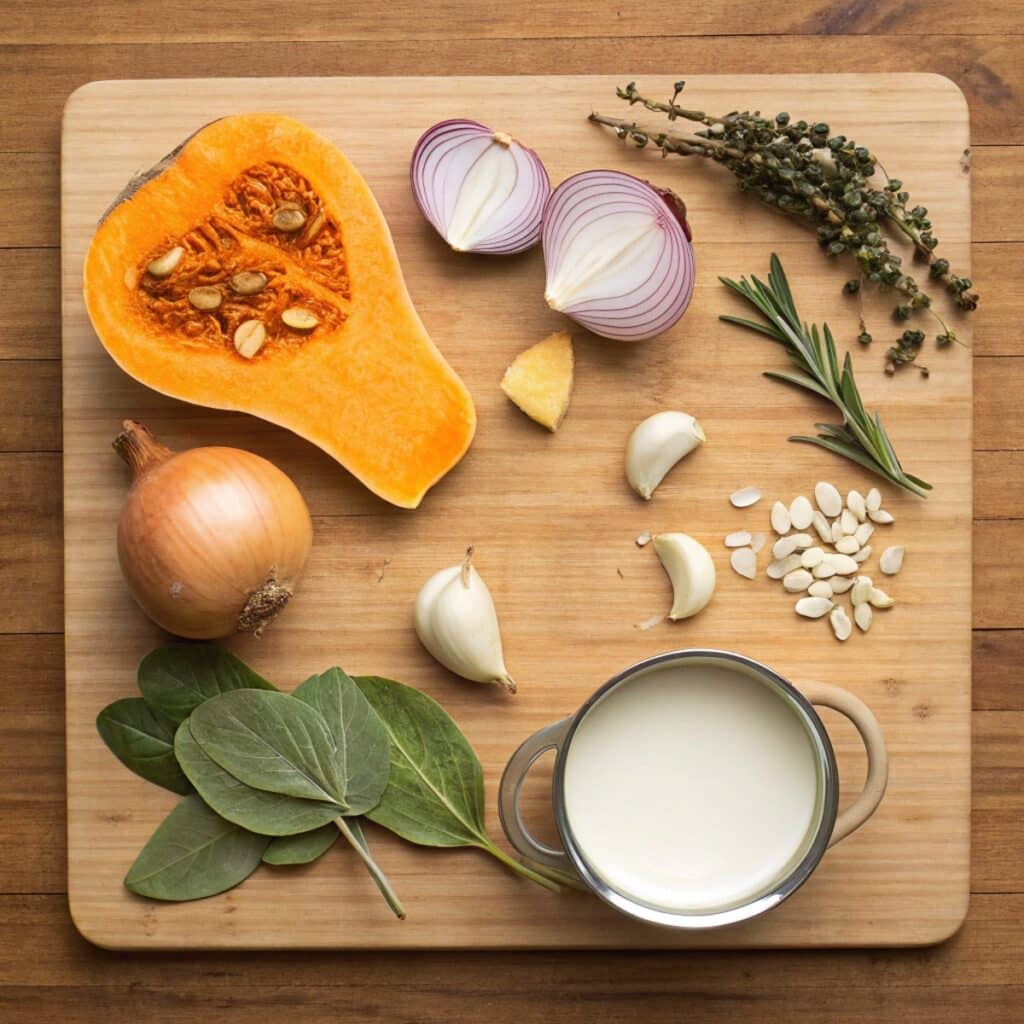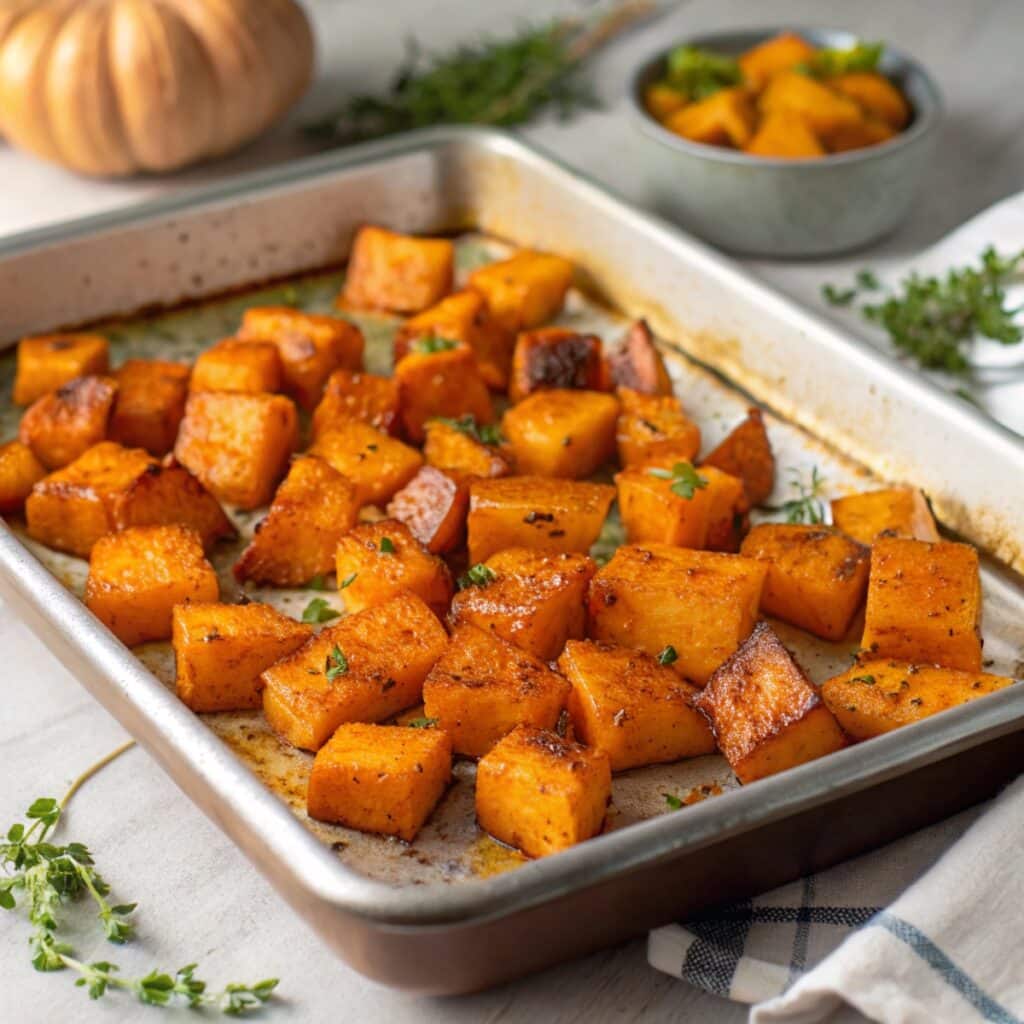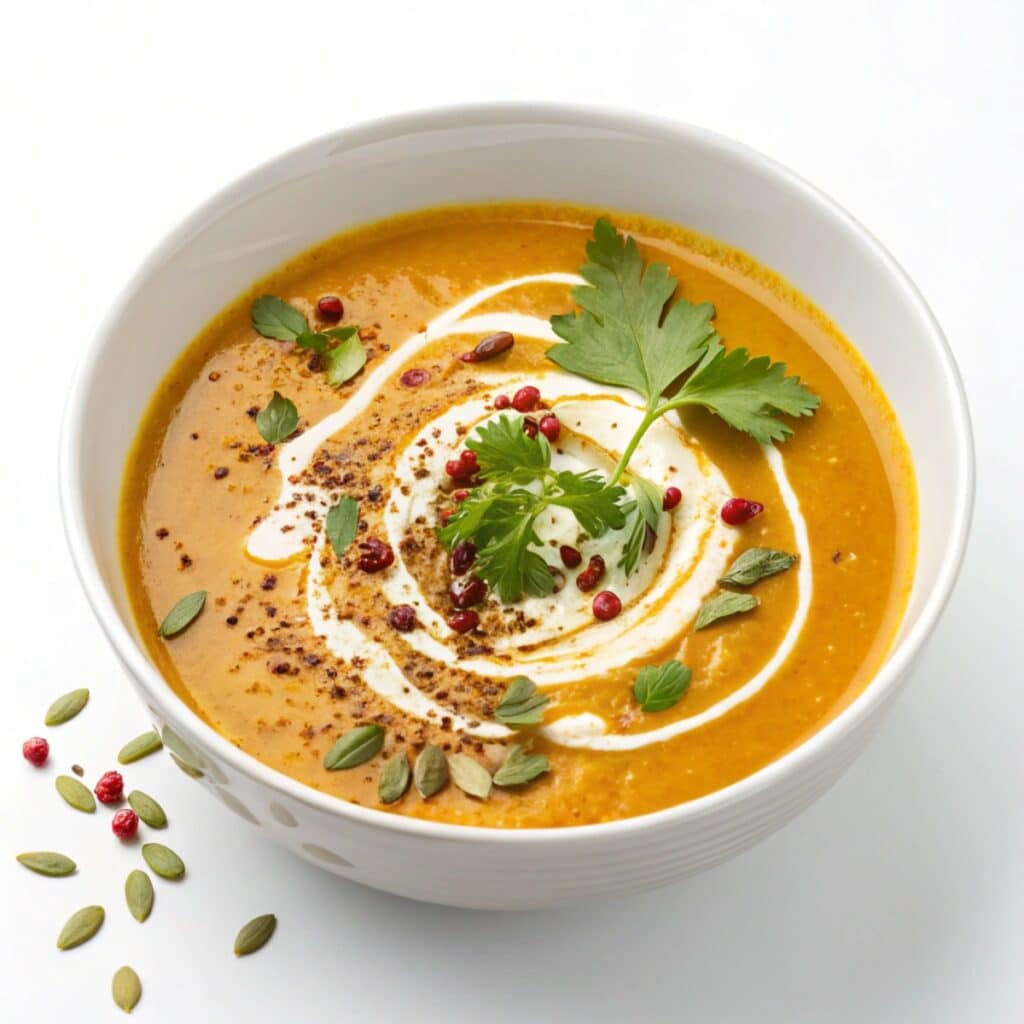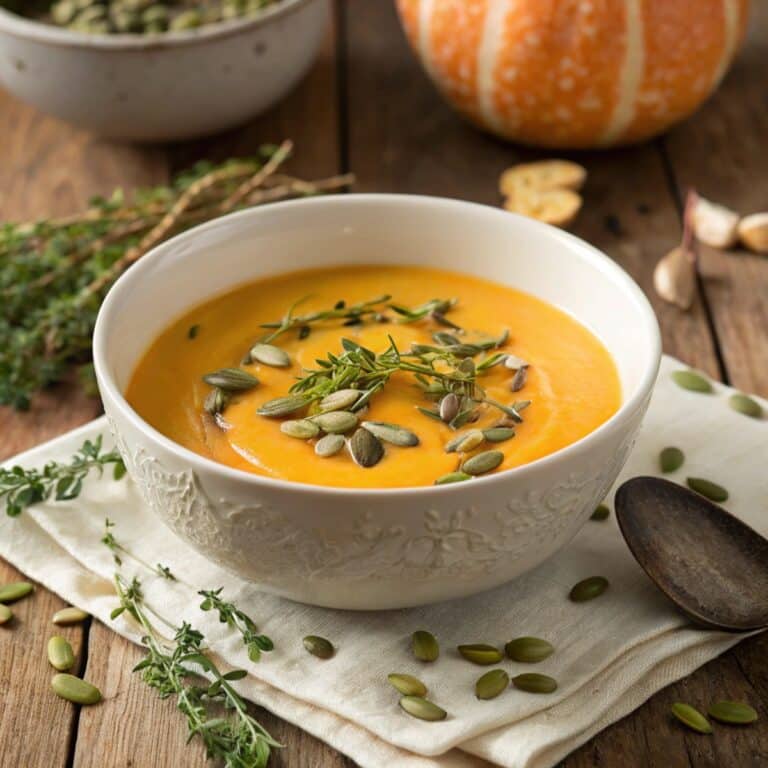I still remember the first time I made butternut squash soup. It was late October, the leaves were just turning in Asheville, and the kitchen smelled like roasted garlic and damp leaves from the garden. I had just picked up a couple of heavy, awkwardly shaped squashes from a local farm stand, not knowing quite what I was going to do with them.
Thank you for reading this post, don't forget to subscribe!What started as an experiment turned into a ritual.
I roasted the squash slowly, almost accidentally discovering how caramelization changes everything. I added a splash of apple cider on a whim something my grandmother used to do with her sweet potatoes and when I tasted the final blend, it stopped me cold. It was simple but deep. Familiar, but new.
Now, every fall, this soup marks the beginning of sweater season in my house. I serve it with toasted sourdough, top it with crispy sage, and smile at how one humble vegetable became my go-to comfort dish.
And every time I make it, I think: this is why we cook.
Table of Contents
Introduction to Butternut Squash Soup
What Is Butternut Squash Soup?
Butternut squash soup is one of those timeless, velvety bowls of comfort that speaks to the soul especially when the weather cools down and you’re craving something nourishing. This soup starts with the golden sweetness of butternut squash, a winter vegetable known for its creamy texture and subtly nutty flavor. It’s often blended with aromatic veggies, warm spices, and either broth or cream to create a silky, comforting dish.
You’ll find countless variations of butternut squash soup, from Thai-inspired with coconut milk and curry to rustic American styles using sage and heavy cream. But the core essence remains the same: smooth, flavorful, and totally satisfying.
Why Everyone Loves This Cozy Fall Favorite
There’s a reason this soup shows up on fall and holiday menus across the country. It’s not just about the flavor (though that’s a huge part). It’s how easily it fits into any lifestyle. It can be vegan, gluten-free, dairy-free, low-carb or creamy, cheesy, and decadent, depending on your mood.
Even better, it’s a breeze to batch-cook and freeze, making it a weeknight hero for busy households. And if you’re looking for a cozy main course pairing, don’t miss our rich and savory Instant Pot Beef Brisket Recipe. The combo is pure comfort food magic.
Using Seasonal Ingredients for Maximum Flavor
Butternut squash hits its peak in the fall and winter months, when it’s fresh, affordable, and full of flavor. Roasting the squash deepens its sweetness, especially when paired with ingredients like caramelized onions, roasted garlic, or even a splash of maple syrup or apple cider.
And if you grow your own herbs or love shopping at your local farmers market, this soup is a fantastic canvas for seasonal touches. You’ll see how sage, rosemary, thyme, and even ginger can completely transform the flavor profile.
Print
Butternut Squash Soup: The Ultimate Guide to Flavor, Health, and Comfort
- Total Time: 1 hour
- Yield: 4 servings
- Diet: Vegetarian
Description
This butternut squash soup is the ultimate fall comfort food smooth, cozy, and layered with roasted flavors, warm spices, and a hint of sweetness. It’s the soup that welcomes sweater weather with open arms.
Ingredients
- 1 large butternut squash, halved and seeded
- 1 tablespoon olive oil
- 1 onion, diced
- 3 cloves garlic, minced
- 1 carrot, chopped (optional)
- 3 cups vegetable or chicken broth
- 1/2 cup apple cider
- 1/2 teaspoon salt
- 1/4 teaspoon black pepper
- 1/2 teaspoon ground cinnamon
- 1/4 teaspoon ground nutmeg
- 1/2 cup coconut milk or heavy cream (optional)
- Fresh sage or thyme, for garnish
Instructions
- Preheat oven to 400°F (200°C). Place butternut squash halves cut-side down on a baking sheet and roast for 40–50 minutes until tender.
- In a large pot, heat olive oil and sauté onion, garlic, and carrot until soft and aromatic.
- Scoop roasted squash flesh into the pot. Stir in broth, apple cider, salt, pepper, cinnamon, and nutmeg.
- Bring to a simmer for 10–15 minutes to meld flavors.
- Use an immersion blender to purée until smooth, or carefully blend in batches.
- Stir in coconut milk or cream, if using, and heat through without boiling.
- Serve hot, topped with crispy sage, thyme, or a swirl of cream.
Notes
Roasting the squash brings out natural sweetness don’t skip it! Adjust seasoning to taste, and experiment with toppings like pumpkin seeds or chili oil.
- Prep Time: 15 minutes
- Cook Time: 45 minutes
- Category: Soup
- Method: Roasted & Blended
- Cuisine: American
Core Ingredients & Secret Flavor Boosters
Must-Have Ingredients for Butternut Squash Soup
At its heart, butternut squash soup is a simple, wholesome blend of ingredients that work beautifully together. Here’s what you’ll need for a classic version:
| Ingredient | Purpose |
|---|---|
| Butternut squash | Sweet, starchy base with velvety texture |
| Onion | Adds depth and natural umami |
| Garlic | Boosts aroma and savory warmth |
| Carrots (optional) | Adds subtle sweetness and color |
| Olive oil or butter | For sautéing and richness |
| Vegetable or chicken broth | Brings everything together |
| Salt & pepper | Essential seasoning |

Some recipes include apple for a sweet-tart contrast, while others sneak in a splash of coconut milk or cream for a decadent twist. We’ll cover those next.
What Is the Secret Ingredient in Butternut Squash Soup?
Ask any home cook or chef, and you’ll hear some wildly different answers to this question but a few secret ingredients come up again and again:
- Apple cider or a splash of apple juice: Adds gentle acidity and brightness
- Fresh ginger: Offers a zingy contrast to the sweet squash
- Maple syrup: Just a teaspoon enhances the squash’s natural sugars
- White miso paste: Brings umami depth without overpowering flavor
- Curry powder or garam masala: A pinch can transform the soup into something exotic
If you like exploring unique flavor pairings, don’t miss our Cottage Cheese Banana Bread for another sweet-meets-savory surprise.
Dairy-Free vs. Creamy Versions: Choosing Your Texture
Texture is everything with a pureed soup and how you choose to finish your butternut squash soup affects both flavor and nutrition. Here are your main options:
| Finish With… | Texture | Flavor Profile |
|---|---|---|
| Heavy cream | Rich, velvety | Decadent and slightly sweet |
| Coconut milk | Silky, dairy-free | Tropical and subtly nutty |
| Greek yogurt | Light creaminess | Tangy and protein-packed |
| Cashew cream | Vegan-friendly | Buttery and smooth |
| No cream | Clean and hearty | Squash-forward and simple |
For a dairy-free crowd-pleaser, coconut milk is a game-changer—especially with warming spices like cinnamon or curry.
Best Cooking Techniques for Depth and Richness
Is It Better to Roast or Boil Butternut Squash for Soup?
Here’s the scoop: roasting wins hands down for flavor, while boiling wins for speed.
Roasting
Roasting your butternut squash caramelizes the sugars, intensifies the sweetness, and adds a subtle nuttiness that boiling just can’t replicate.
- How to Roast:
Halve the squash, remove the seeds, brush with oil, and roast cut-side down at 400°F for 40–50 minutes. Scoop out the flesh once tender. - Flavor profile: Sweet, complex, slightly smoky
- Best for: Elegant or holiday-ready soups
Boiling
Boiling cubed squash directly in broth is quicker and easier ideal for weeknights.
- How to Boil:
Peel and cube the squash, then simmer in broth for 15–20 minutes until fork-tender. - Flavor profile: Milder, softer
- Best for: Lightened-up or quick prep versions
Pro tip: For even more depth, roast your aromatics alongside the squash or toast your spices briefly in the pot.
Sauteing Aromatics: Onion, Garlic, and Beyond
Don’t underestimate what sautéed onions and garlic can do. These humble ingredients bring savory depth and balance the natural sweetness of the squash.
Try experimenting with:
- Shallots or leeks for a more delicate flavor
- Celery and carrots for a mirepoix base
- Ginger or turmeric for added warmth and brightness
Let the aromatics sweat for a few minutes in olive oil or butter before adding your squash and broth. This tiny step delivers huge returns.

Using an Instant Pot, Slow Cooker, or Stove Top
No matter how you prefer to cook, butternut squash soup is flexible. Here’s how each method compares:
| Method | Time | Pros | Cons |
|---|---|---|---|
| Instant Pot | 10 min pressure | Fast, one-pot, hands-off | Less caramelization |
| Slow Cooker | 4–6 hours | Great for set-it-and-forget-it | Requires planning ahead |
| Stove Top | 25–35 minutes | Classic method, more flavor control | Slightly more active cooking |
Looking for hearty soups with a kick? Don’t miss our Sausage Lasagne Soup it’s bold, rich, and perfect for chilly nights.
The Best Broth and Additions for Next-Level Taste
What Broth Is Best for Butternut Squash Soup?
The broth you choose is the backbone of your soup. It affects everything from saltiness and mouthfeel to depth and nuance.
Top Choices:
- Vegetable broth:
Best for vegetarian or vegan versions. Choose low-sodium to avoid overpowering the sweetness of the squash. - Chicken broth:
Adds richness and body without being too heavy. Homemade or bone broth versions bring out a natural savoriness. - Beef broth:
Rarely used, but if you want intense depth, a splash can work though it might dominate the squash.
For best results, use broth that’s been simmered with onion, celery, garlic, and herbs. Or better yet, make your own. It’s easier than you think and adds serious flavor cred.
What to Add to Butternut Squash Soup to Make It Taste Better?
Even a great soup benefits from a little finesse. Here are chef-approved flavor enhancers to try:
| Ingredient | Impact |
|---|---|
| Acidity (apple cider vinegar or lemon juice) | Cuts through richness, brightens |
| Sweetness (maple syrup or honey) | Enhances the squash’s natural sugars |
| Heat (cayenne, chili flakes) | Balances sweetness with a kick |
| Umami (miso paste or soy sauce) | Adds savory depth and richness |
| Spice blends (curry, Chinese 5-spice) | Offers global twists and complexity |
Start with a small amount of one or two, taste, then adjust. Trust your palate.
Want something a little sweet to pair with all this savory? Cottage Cheese Banana Bread makes a surprising and wholesome side.
Herbs and Spices That Pair Beautifully with Butternut Squash
Butternut squash is mellow and sweet, making it a perfect match for a wide range of spices and herbs. Here are the top picks:
Warm Spices:
- Cinnamon
- Nutmeg
- Ginger
- Allspice
- Smoked paprika
These work especially well in fall-inspired or sweet-savory soups.
Fresh or Dried Herbs:
- Sage – Classic fall herb, pairs beautifully with squash
- Thyme – Adds woodsy depth
- Rosemary – Use sparingly; it’s pungent
- Bay leaf – Simmer whole, then discard
Herb tip: Add dried herbs early and fresh herbs at the end for brightness.
Don’t forget bread matters too! Try our Gluten-Free Sourdough Bread for a crusty, chewy companion that’s perfect for dipping.
Nutritional Benefits of Butternut Squash
Is Butternut Squash Healthier Than Potatoes?
If you’ve ever wondered whether butternut squash edges out potatoes on the nutrition front, the short answer is: yes in many ways.
Here’s a quick breakdown:
| Nutrient | Butternut Squash (1 cup, cooked) | White Potato (1 cup, cooked) |
|---|---|---|
| Calories | 82 | 130 |
| Carbs | 22g | 30g |
| Fiber | 7g | 3g |
| Vitamin A | 457% DV | 0% |
| Potassium | 582 mg | 610 mg |
| Vitamin C | 52% DV | 28% DV |
Butternut squash offers more fiber and dramatically more vitamin A, which supports immune health, vision, and skin. It also contains beta-carotene, a powerful antioxidant not found in white potatoes.
That said, both have a place in a balanced diet. If you’re watching carbs or looking for a lower glycemic option, squash is your go-to.
Calories, Carbs, and Vitamins: A Quick Comparison
Butternut squash soup is naturally lower in fat and calories especially if you skip the heavy cream. Here’s what one serving of a classic recipe typically looks like:
- Calories: ~130
- Fat: 5g (less if made without dairy)
- Carbohydrates: 20–25g
- Fiber: 4–6g
- Protein: 2–3g
- Vitamins:
- Vitamin A: 300–450% DV
- Vitamin C: 30–50% DV
- Magnesium, manganese, and folate: moderate levels
It’s a nutrient-dense soup that delivers a lot of value for very few calories. And thanks to its fiber content, it’s filling too.
Making It Vegan, Gluten-Free, or Keto-Friendly
Butternut squash soup is one of the most adaptable dishes out there. Here’s how to make it fit your diet:
| Dietary Style | Tips & Swaps |
|---|---|
| Vegan | Use veggie broth, coconut milk, or cashew cream instead of dairy |
| Gluten-Free | Naturally GF just double-check your broth labels |
| Low-Carb/Keto | Use less squash, blend in cauliflower or zucchini to cut carbs |
Want something refreshing on the side? Learn how to Make a Matcha Latte Iced for a cool contrast to warm soup.
Customizations, Pairings, and Serving Tips
What Herbs Pair Well with Butternut Squash Soup?
Herbs can elevate butternut squash soup from good to unforgettable. Whether you’re aiming for earthy, fresh, or bold flavors, here are some excellent matches:
Top Herb Pairings
- Sage – the go-to herb for autumnal squash dishes; warm and woodsy
- Thyme – balances sweetness with subtle sharpness
- Rosemary – strong and piney; use sparingly
- Parsley – adds fresh brightness right before serving
- Chives – perfect as a garnish for a touch of oniony bite
Try a combination of sage and thyme if you’re going for a rustic feel. Or pair rosemary with a splash of lemon juice for something fresher.
Best Toppings: Croutons, Seeds, Cream Swirls, and More
Toppings do more than look pretty they add texture, richness, and contrast. Here are some easy add-ons to bring variety to your bowl:
| Topping | Why It Works |
|---|---|
| Toasted pepitas (pumpkin seeds) | Nutty crunch that complements squash |
| Garlic croutons | Crispy texture and garlicky punch |
| Coconut milk swirl | Creamy and dairy-free richness |
| Greek yogurt dollop | Tangy contrast and protein |
| Crispy sage leaves | Crunch + flavor explosion |
| Chili oil drizzle | Heat and color for a restaurant vibe |
| Grated Parmesan | Salty umami for non-vegans |

For added fun, serve your toppings DIY-style at the table so everyone can dress their bowl their way.
What to Serve With Butternut Squash Soup (Salads, Bread, Wine)
Butternut squash soup is hearty on its own but pair it with the right sides and drinks, and it becomes an experience.
Best Salads
- Checkerboard Salad – colorful, crisp, and full of contrast
- Summer Ribbon Salad – light and refreshing with herbal notes
Bread & Baked Sides
- Gluten-Free Sourdough Bread – chewy, tangy, and soup-perfect
- Cottage Cheese Banana Bread – sweet-savory fusion if you’re going bold
Drinks & Wine
- White wine: Try a lightly oaked Chardonnay or a dry Riesling
- Herbal teas: Chamomile or mint balance out the richness
- Sparkling water: A splash of citrus adds freshness
And if you’re looking for another cozy soup option, don’t miss our creamy Sausage Lasagne Soup.
Frequently Asked Questions
What is the secret ingredient in butternut squash soup?
The most common “secret” ingredient is apple cider or maple syrup both bring out the natural sweetness of the squash and add a touch of acidity or depth. Others swear by a splash of white miso, fresh ginger, or a pinch of curry powder to give the soup a unique edge. The right secret ingredient depends on whether you’re going for sweet, spicy, or savory.
What broth is best for butternut squash soup?
Vegetable broth is best for a lighter, plant-based flavor, while chicken broth brings more richness and umami. If you’re after a more robust soup, go with low-sodium chicken bone broth. For vegan versions, stick with a high-quality homemade or store-bought vegetable stock.
What to add to butternut squash soup to make it taste better?
Try layering in ingredients that hit sweet, acidic, and savory notes:
Maple syrup or roasted apple for sweetness
Lemon juice or apple cider vinegar for acidity
Miso paste, soy sauce, or nutritional yeast for umami
Chili flakes or cayenne for subtle heat
Fresh herbs like sage or thyme for complexity
These small additions can completely transform the flavor profile.
Is butternut squash healthier than potatoes?
Yes, in many ways. Butternut squash is lower in calories and carbs, higher in fiber, and packed with vitamin A (beta-carotene) offering over 400% of your daily recommended intake in just one cup. It’s also rich in vitamin C and potassium, making it a more nutrient-dense choice than white potatoes.
Is it better to roast or boil butternut squash for soup?
Roasting brings out a sweeter, richer flavor by caramelizing the squash’s natural sugars. Boiling is faster and more convenient but produces a milder flavor. If you’re short on time, boiling works great otherwise, roasting is the preferred method for depth and complexity.
What herbs pair well with butternut squash soup?
Herbs like sage, thyme, and rosemary are ideal companions. They add earthiness that complements the squash’s sweetness. For lighter versions, use parsley or chives at the end for brightness. Try steeping a bay leaf during cooking for a subtle herbal layer, then remove it before blending.
Conclusion: Make Butternut Squash Soup Your Signature Bowl
Butternut squash soup is more than a recipe it’s a ritual. A warm, velvety bowl that welcomes seasonal ingredients, dietary preferences, and personal touches. Whether you prefer yours with roasted garlic and sage, a splash of coconut milk, or a zing of chili oil, this soup flexes to fit your style.
It’s quick enough for a weeknight and elegant enough for guests. It freezes like a dream, pairs beautifully with salads and breads, and offers nourishing comfort in every spoonful.
If you’re ready to elevate your soup game, start simple and taste as you go. Add a swirl of miso, a drizzle of maple syrup, or a crunch of toasted seeds. No matter how you tweak it, you’re creating something delicious and deeply satisfying.
Looking for the perfect side? Check out our colorful Checkerboard Salad it’s crisp, bright, and a stunning companion to this golden bowl of goodness.
Follow us on Facebook for fresh new recipes, cooking tips, and food inspiration every week!

